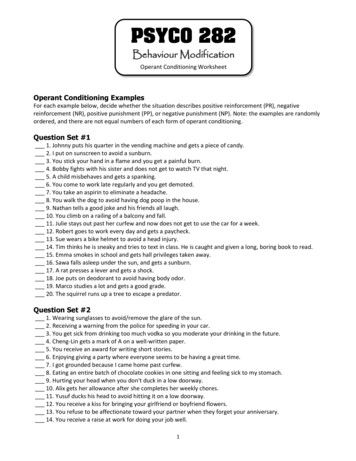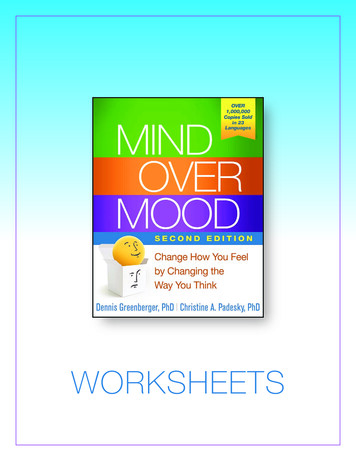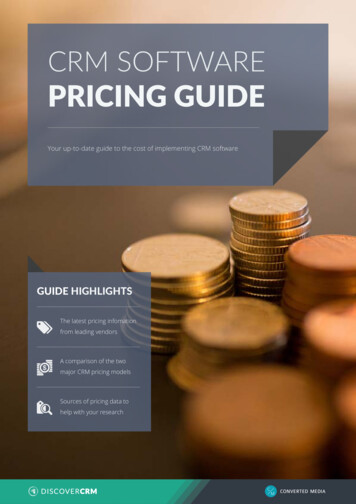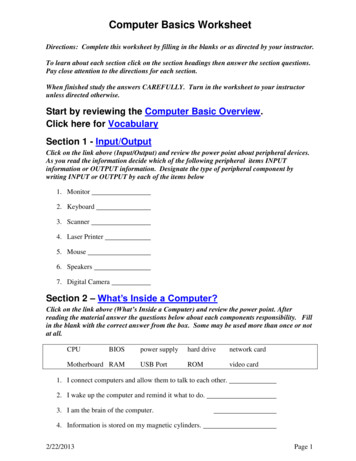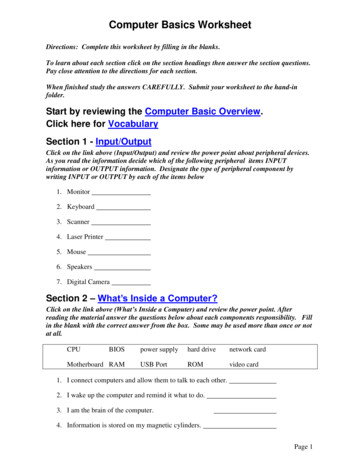
Transcription
CLEAR FORMR Worksheet - Pricing Models for a Successful BusinessThe concept of “price” is a topic many entrepreneurs ponder as they begin shaping their businessideas. In the Introduction to Pricing course, you learned about three pricing models—Costbased Pricing, Customer-based Pricing, and Competition-based Pricing. This course exploresthose pricing models and discusses topics to help you adapt your pricing to your market.Of the four “Ps” in the marketing mix, Price is the onlycomponent thatgenerates revenue; Product, Promotion, and Place are all costs.Use this worksheet to document your thoughts, ideas, and action items as they relate todeveloping a pricing model for your business. The questions below follow the topics discussed inthe course. You can use the fillable PDF form fields or print the worksheet and write in the spaceprovided.Cost-Based Pricing ModelTo implement a cost-based pricing model, you first need to calculate the costs incurred byproducing, marketing, and distributing your product or service. Use the space below to calculatethe different variable and fixed costs for your product or service.Variable Costs: Write down the variable costs you have to produce your product or deliver yourservice. To make this easier, try to do this for an average year or month. For example, if younormally product 5,000 units a month use that as your basis to calculate these costs.Item(For example, Flour)Cost(e.g., 500.00)# of units produced(e.g., 5,000 )Cost Per Unit( 500.00/5,000 0.10)TOTAL VARIABLE COST PER UNIT:Next, add up all of the costs in the “Cost Per Unit” column:This is your total variable cost per unit.Page 1 of 7Reset Table
R Worksheet - Pricing Models for a Successful BusinessFixed Costs: Now, write down all of the fixed costs you have. If you were able to calculate yourvariable costs based on your monthly production rate, use your monthly fixed costs here.Item(For example, Rent)Cost(e.g., 2,000.00)# of units produced(e.g., 5,000)Cost Per Unit( 2,000/5,000 0.40)TOTAL FIXED COST PER UNIT:Next, add up all of the costs in the “Cost Per Unit” column:This is your total fixed cost per unit.Reset TableYou can find your total cost per unit by adding your variable cost per unit and your fixed cost perunit:(Variable Cost Per Unit) (Fixed Cost Per Unit) (Total Cost Per Unit)Adding Markup: Separating your costs into variable and fixed costs allows you to performdifferent calculations and play around with various factors to see how they influence your prices.By changing these factors, you can reduce costs to increase profits or decrease prices to increasesales and market share. What percent markup would you like to add to your product?HINT: Your markup should allow you to make a reasonable profit. If your Total Cost Per Unit ismore than your current price, your business is losing money.To find your final price, first calculate your Markup Cost by multiplying your Total Cost PerUnit with the Markup % you chose. Convert your Markup % to a decimal (e.g. 5% .05).(Total Cost Per Unit)x(Markup % as decimal) (Markup Cost)Then, add your Markup Cost to the Total Cost Per Unit for your final price:(Markup Cost) (Total Cost Per Unit)Page 2 of 7 (Final Price)
R Worksheet - Pricing Models for a Successful BusinessCustomer-Based Pricing ModelThe Customer-based pricing model, also called value-based pricing, involves using informationabout your customers to set a price. To implement a customer-based pricing model, you need tostudy the market in order to understand how much your customers can and are willing to pay.Finding this out requires you to do some research.Use the table below to write down your plan and results for different customer research ideas.Research IdeaExecution sionmaking ProcessMeasure Effectof PricesMonitor SocialMediaResearchCustomerPerceptionPage 3 of 7Results
R Worksheet - Pricing Models for a Successful BusinessOften times in the Customer-based pricing model, you will offer your product at different pricesto different segments in your target market. These segments are divided based on the customers’requirements, attitudes, culture, and various other characteristics. Use the table below to identifymarket segments that you’ll need to target and write down information about how you might dothat.Market Segment &Description(e.g., France:This is the market Iexport to in France )Segment Size 1,500,000 annually 15% of my salesSegment PriceConsiderationsLess sensitive to pricethan my other segments– I could charge 10%more and not lose salesPage 4 of 7Segment Price 10/each
R Worksheet - Pricing Models for a Successful BusinessCompetition-Based Pricing ModelWhen using the Competition-based pricing model, a business sets is prices based on where itscompetitors set theirs. Like the Customer-based pricing model, the Competitor-based modelrelies heavily on research.Use the table below to write some information about your competitors:CompetitorEg: Acme ProductsDescriptionOnline store that offersthe same widgets that IsellAnalysisThe widgets are the samebut Acme Products doesn’toffer a guarantee.However, they areconsidered the leader inthe widget industry.Page 5 of 7PriceAcme price is 5/widget Iwould probably need to sellat that price to bring incustomers because they areso popular, even though Ioffer a guarantee.
R Worksheet - Pricing Models for a Successful BusinessBreakeven AnalysisRegardless of the pricing method you chose, a breakeven analysis is essential to determine thevolume of sales you need to achieve to recover your costs at a certain price. You will need theVariable and Fixed Costs you calculated in the cost-based pricing section as well as the price youplan to charge for your product.To find the Breakeven Quantity (BEQ) that you must sell each month to cover your costs use thefollowing formula.Fixed Costs Per MonthBEQ --------Price per unit – Variable Cost per unitBreak-Even Quantity CalculatorVariable Cost Per Unit:Fixed Cost Per Month:Price Per Unit:BreakEven Quantity:Clear CalculatorWhat is your BEQ for each month?Do you think you can sell that many units each month at that price? Remember to setachievable goals. Then, track their progress and make adjustments based on results. Howwould changing your price affect the amount of units you need to sell?Selecting Your Pricing ModelNow that you’ve analyzed the various pricing models for your business, which one is right foryour business? Will you need to mix some aspects of each model? What do you think your finalprice will be?.For example, you calculate your costs to be 5/unit (Cost-based). You know your competitorsells a similar product for 10/unit. So – you sell your product at 9.50/unit (Competitionbased). Knowing what your competitor sells for helped you decide what markup to add to yourproduct.Similarly, if you know your competitor sells for 10/unit (Competition-based), but yourcustomers are willing to pay a little more as long as you offer free installation (Customer-based),you may charge 15/unit and offer free installation based on both your competitor’s price andwhat your customer is willing to pay. Regardless of which model you use as the basis for yourprice, you should also consider your costs, customers, and competition to ensure you’re offeringthe right price.Page 6 of 7
R Worksheet - Pricing Models for a Successful BusinessRESOURCES:This worksheet is intended to help you document your ideas and possible solutions to commonchallenges small businesses face daily. You are not alone! If you would like talk to someoneabout your business, the SBA has a broad network of skilled counselors and businessdevelopment specialists waiting to help your business start, grow, and succeed. Below is a shortdescription of our resource partners: There are more than 1,000 Small Business Development Centers (SBDCs) located aroundthe country. SBDCs provide management assistance to current and prospective smallbusiness owners. SCORE is a powerful source of free and confidential small business advice to help buildyour business. More than 10,000 SCORE volunteers are available to share their experiencein lessons learned in small business. Women’s Business Centers (WBCs) assist women and men in achieving their dreams byhelping them start and run successful businesses. Over 90 WBCs are located around thecountry. The SBA has over 60 District Offices located throughout the country to help you start andgrow your business. The SBA Learning Center is a powerful virtual campus with online training, videos, toolsand links to local resources. The SBA’s Office of Women’s Business Ownership (OWBO) serves as an advocate forwomen-owned businesses. The office oversees a nationwide network of 110 Women’sBusiness Centers that provide business training, counseling and mentoring gearedspecifically to women, especially those who are socially and economically disadvantaged.The program is a public-private partnership with locally based nonprofits. The Veterans Business Outreach Program (VBOP) is designed to provide entrepreneurialdevelopment services such as business training, counseling and mentoring, and referrals foreligible veterans owning or considering starting a small business. The SBA has 15organizations participating in this cooperative agreement and serving as Veterans BusinessOutreach Centers (VBOC). Procurement Technical Assistance Centers (PTACs) provide local, in-person counselingand training services for you, the small business owner. They are designed to providetechnical assistance to businesses that want to sell products and services to federal, state,and/or local governments. PTAC services are available either free of charge, or at a nominalcost. PTACs are part of the Procurement Technical Assistance Program, which isadministered by the Defense Logistics Agency.Find all your local resources in one place using our handy zip-code tool: www.SBA.gov/localassistanceFor more information about SBA programs and services, please download the 2014 ResourceGuide for Small Business, available for download at the following URL:http://www.sba.gov/about-sba/what we do/resource guidesPage 7 of 7
those pricing models and discusses topics to help you adapt your pricing to your market. Of thefour"Ps"inthemarketingmix, Price. istheonlycomponent that osts. Use this worksheet to document your thoughts, ideas, and action items as they relate to developing a pricing model for your business.

